Description
This website page is devoted to the ArCH-AOA Architect-Owner Agreements.
ArCH-AOA Architect-Owner Agreement
© Copyright 2014-23, ArCH: Architects Creating Homes, LLC
ArCH-AOA
$95 ArCH Members, $175 non-members (join ArCH now and reduce your cost)
Newly updated! Now Available! File download is in MS Word 2013, for 64-bit w7-w10 PCs. You will be able to enter your ArCH discount coupon code in the Shopping Cart during the ordering process to reduce your cost (if you are an ArCH member). Once you understand all of the terms in this agreement and how it can improve your practice, you’ll realize that the value of this form is worth many times this charge.
Click on the Add To Cart button above to order, pay online and download.
When you consider that this economical brief agreement form could possibly save you potentially tens of thousands, if not hundreds of thousands of dollars in defense fees, judgements, wasted time, bad feelings and other negative results, it is a wonder the entire world of Architects who design homes isn’t already using this form. Some Architects using this form presented it to their Errors & Omissions insurance carriers, most of whom immediately reduced the rates for those Architects, due to this fair and practical agreement prudently managing many of the issues and risks missed by so many other agreements (that are not as well-suited to the unique risks inherent in residential architectural practices).
THE ONLY ARCHITECT-OWNER AGREEMENT FORM FOR RESIDENTIAL PROJECTS IN THE WORLD
This is the long-awaited form of agreement between an Architect and their residential Client. Since the beginning of time, to ArCH’s knowledge, this is the only form of agreement specifically tailored between these parties, tailored to residential architectural practice. You no longer have to scale-down a larger commercial agreement to work for your residential Clients. After you make simple adjustments for your practice, it is expected that this AOA will be about 16 face-pages, which should end up as about 8+/- physical duplexed pages (printed front & rear). It is important to have your agreement be simple and as compact as possible. Large contracts scare people. Understanding this, this form was created with efficiency, clarity of common language, & non-lawyer-speak to shorten clauses as much as possible, while still communicating.
It has long been a complaint of residential Architects that larger agreements prepared by other organizations intended for huge commercial projects are too imposing for Architects’ residential projects. This AOA form deftly addresses this in a compact and yet detailed manner, managing dozens of issues of substance facing all residential Architects. ArCH has no means to allow a preview of this form before buying it. It is so brief and yet so detailed that you will need to buy it to see it and start using it. See the brief reviews of some of the paragraphs below for a taste of how your practice can be much better managed, allowing you to sleep better at night, knowing that your Client has a more realistic understanding of what you are doing (and not doing) and the responsibilities of both parties.
EFFICIENT, PLAIN LANGUAGE
It is a true marvel of agreement language. Multiple Attorneys have worked alongside leading nationwide practicing residential Architects developing this form over the last 3 decades. And now, it is available for your use. All the lessons learned over about a third of a century of real-world practice is built into this agreement. You will find that many of the clauses will educate your Clients as you review the agreement with them. For instance: that you, as the Architect, cannot promise that your Client’s project will be bid and built by a General Contractor for the expenditure amount that your Client would prefer. The courthouses of America are filled with the good intentions of Architects who promise such things. This agreement says what you need to say for you, and clears the way for a clearer alignment of expectations from both parties.
EASY TO EDIT
Unlike some other organization’s agreements, that have complicated software frustrating your attempts to edit them, this agreement is in its native MS Word file format. Simple. Easy. And no list of changes you have made to the agreement hanging around at the end. Cleaner. More compact. Make it to suit your practice.
CONSTANTLY UPDATED. NOW INCLUDING BUNDLED SERVICES
Newly updated! All the latest best practices included, with BUNDLED SERVICES listed in a single (duplexed) page entitled: Professional Services Package Menu. Never before has this been done, anywhere, for Architectural practice: you start by offering this simple, single page (both sides) “menu” of your services. Packages are arranged into:
Basic
Intermediate
Advanced
Advance+
Comprehensive
bundles of services. What is in each bundle? While ArCH has made a reasonable grouping of suggested services, YOU make that final decision: edit the bundles to suit your practice. Simple. You can help your Client to chose 1 of 5 packages. Then, after this first choice is made and initialed, you attach this menu page to the back of the main agreement and review the main agreement. This involves as much psychology as good business sense, while simplifying the contract review process, which is a critical step in obtaining a signed agreement for a new project. Sitting down, instead, with a more imposing contract without ArCH’s one of a kind Menu page is not providing the level of simplicity your Clients would appreciate.
New section recently added:
EXPECTATIONS
This new section deals with Managing Client Expectations, a very important issue these days, as determined during a recent ArCHexComm session. What your Client expects your fees to be (and proportionately more where and when), expects your length of time to be and expects their cost of construction to be. Difficult things to address if you’re not prepared with the ArCH AOA, which deftly handles all of these issues in one compact paragraph. This wonderful paragraph finally allows you to actually insert links to 3rd party websites that document what construction costs typically are these days and whatever other links you may wish to insert to disclose what typical fees might be. MANAGE YOUR CLIENT’S EXPECTATIONS with the new ArCH AOA. Includes a nice little diagram: the Architectural Project Work Distribution Diagram:

Client are required to initial the Expectations paragraph, so you hopefully will have less of “I didn’t expect that…” issues to deal with, and you can refer to the paragraph the Client initialed, indicating that they Did understand and expect what is happening. Such as: the range of the amount of their invoices, how much time you take to produce their project, and what their project costs to build (per any linked websites you may chose to insert). This one paragraph alone can help improve your Client relations and educate Clients regarding what to expect on their project. Every agreement should have such paragraph. This is ArCH: Improving Residential Architecture and your practice of it.
COMMUNICATIONS
The ArCH AOA include an efficient section on how often your Clients want you to contact them for project updates, and using what medium.
COORDINATED WITH OGCA FORM
The AOA form is coordinated with the ArCH OGCA™ (Owner-General Contractor Agreement) and the ArCH4 in 1™ (Bid Form, Value Engineering, Schedule of Values, and Pay Request Form), and ArCHspec™ (ArCH’s residential specifications system). Never before has there been such an integrated suite of forms, agreements, and specifications to assist the agreement & design methodology, production of CDs (Construction Documents), Bidding, CA (Construction Administration) and management of the entire process.
NOTICE: the AOA form is the Architect-Owner Agreement file ONLY. To obtain ArCHsuite™ as a bundled product including many of the the other coordinated products mentioned above, click here: ArCHsuite™
YOU NEED TO HAVE REVIEWED
Does it promise to be perfect in all 50 states in the USA right out of the box? No, of course not. As a matter of fact, the form’s instructions require you to have at least one Attorney, in the state of your office to review the form and make any revisions necessary for your office location. Also, you are strongly advised to have the counsel of an Attorney in the state of the project to also review and revise the agreement as required, in order to improve its language and clauses to insure compliance in both the state of your office and that of the project. Why? Because the law is constantly changing, and no two states have identical laws. However, this agreement form has been created with the goal of creating the perfect form of agreement for the entire USA. Has this been achieved? Probably not. However, it may be closer than any other, because to our knowledge, there is no form of agreement that specifically addresses the critical issues faced by residential Architects everyday.
WHO CREATED THIS AGREEMENT
THIS AGREEMENT FORM WAS CREATED BY SEASONED, LICENSED PRACTICING RESIDENTIAL ARCHITECTS AND THEIR ATTORNEYS FOR THEIR OWN RESIDENTIAL ARCHITECTURAL PRACTICE.
TERMS TO WHICH YOU MUST AGREE
See the Terms associated with all ArCH purchases during check out, to which you must agree to complete the buying process.
In addition to those terms, these also apply:
No merchantability or fitness of purpose is promised or guaranteed with your purchase of this form. However, you may find it more useful than other forms that are not specifically addressing residential architecture. There is no promise made that there are not flaws in the form that Must be revised by your Attorney(s) in order to avoid significant legal problems, particularly in your specific State. This form is Not a contract until your Attorney(s) review, revise and correct the language so that it complies with the laws for your architectural office location and for the location of your project. ArCH is not practicing law with the offer of this form. Only your Attorney(s) can legally do that. ArCH is simply offering a form for sale that has been a good starting point for an agreement, that must be completed and edited by your legal counsel. Do Not proceed to use this form without legal counsel.
VARIOUS ISSUES ADDRESSED BY THIS AGREEMENT:
———————————————————————-
Dispute Resolution Process
This is established as binding arbitration, for a number of reasons. You’ll need to buy the form to understand why this is so critical to your practice.
Venue
Related to the issue above. You need to be in control of this. Think about where your projects are located and where your office is located. This alone can be worth the price of this form x thousands, if you haven’t properly covered this issue.
Recoverable Costs
Services To Be Provided: BUNDLED SERVICES:
This latest updated version of the ArCH AOA “bundles” services into different packages or bundles: Basic, Intermediate, Advanced, Advance+, Comprehensive. What you choose to offer in each of these bundles is up to you to edit. Make it your own. Why: leading architectural marketing professionals have proclaimed that Architects should be bundling their services. Offering 3 to 5 plans is a simpler situation for Clients to understand than 25 to 50 line item services, even though those line-item descriptions are provided. Sort of like buying a vehicle: there’s the “L”, the “LT”, the “LTZ”, the “Sport” and the “Limited.” If the car-buying public had to instead try to package their own grouping of 30 to 100 line item options, there would likely be more confusion and fewer sales. So now bundling comes to architectural services, from ArCH. Bundles the line items as you wish and add your own. Examples are provided to get you going. And you can name each of your bundles whatever you wish. For instance: “Tier 1 services”, “Tier 2”, “Tier 3” and so on. Or “Iron Plan”, “Copper Plan”, “Silver Plan”, or variations on those. The idea: to offer your Clients packages of services that help you obtain payment for providing groupings of related services that better serve your Clients’ needs and help you to obtain compensation for activities you are performing for no compensation now, or for unprofitable amounts, or not providing at all.
ArCH has prenamed the Bundles:
BASIC PLAN
INTERMEDIATE PLAN
ADVANCED PLAN
ADVANCE+ PLAN
COMPREHENSIVE PLAN
ArCH has done so with great thought about the psychology associated with such names for your services. ArCH realized that using such names as “Gold” or “Platinum” could actually backfire. Clients might regard such package names as beyond their means or luxuries they do not need. While this may or may not work for the automotive industry, it is not suggested for architectural service descriptions. What Architects want is to sell more services that allow them to better manage projects for their Clients. Therefore, you’ll want to use service bundle names that might perhaps make Clients feel that they desire more comprehensive services. And that allows the Architect to do a better job. So, ArCH is hoping that such naming results in a win-win, where Clients obtain more services and Architects have more compensation that allows them to provide thorough attention to their projects.
There are NOTES to the Client indicated after each bundled package. You are welcome to modify those notes to best serve your practice. The important idea to communicate in those notes: What your Clients are receiving in each package (in these closing notes after each package). This phrasing will typically be more conversational than your description of services above, as it should be. You are trying to explain, in lay-people’s language what your Client gets for his/her money. World-class architectural marketing professionals have advised ArCH that Architects usually do not explain in common language, the results of the services they offer. This form attempts to help you accomplish that. What we all offer is complicated and technical and most lay people will never completely understand it. It is part of our job to try to phrase the results of what we do in a manner that they can understand.
Also, some of these notes indicate what problems could occur if they do Not have you perform certain optional services and instead rely on the Contractor to “work things out.” Those are probably wise to leave in the agreement, as if those negative things happen, you have evidence right there in your agreement, telling the Client that those bad things could happen if they didn’t have you perform those extra services. These notes could result in your Client engaging you to perform the various packages of services, so they can avoid such problems. If you don’t explain these consequences, they might not otherwise understand that bad things can happen without you providing those services, and think they are just added costs. It is part of your job, both verbally, and in your agreement, to effectively communicate the VALUE of the services you offer. Do not be embarrassed to explain why you are worth more for doing more.
Basic Services (under the first “bundle”)
This spells out what phases of work you will be doing and that you define those. You are welcome to add more language here or to keep it simple. The latest version also spells out that you are not providing any hardcopy paper sets (unless you want to do so) and that your deliverable is typically in the form of a PDF or other format you determine. This is a must for the Internet Age. Don’t get stuck having to furnish expensive paper sets. And yes, your signing & sealing of hardcopy sets furnished by the selected GC is dealt with as well, to comply with State BOA requirements.
Also, in this Basic Services description, the AOA indicates that your Client understands and agrees that you, the Architect, will be assigning various items to Owner Optional Upgrade Packages and others to the Base Bid Package. This puts you, the Architect, exactly where you should be: in control of what “wish list” items your Client wants (which can be budget busters) into an options list, and what basic things are in the Base Bid. This helps you obtain lower prices on Bid Day for the Base Bid Package, while obtaining specific prices for each of your and your Client’s hoped-for extras, allowing them to make informed choices as to what items they would like to pay for to have built into the project. This can work big magic on Bid Day, to help avoid the finger-pointing and anger that can occur if the Architect includes anything and everything their Clients can imagine into just one, huge bid number.
And have you ever found yourself Not charging your Client for some of the services you perform, even though you deserve to be paid for them? For instance: your very valuable coordination with engineering? Well, the AOA has that covered! You will get paid for your coordination efforts with engineers and other project consultants from now on, because the AOA specifically indicates that the Client understands and agrees to compensate you for your time providing these services. The AOA will help you be more properly paid for your work.
Additional Optional Services
(in the various bundles as simple names, then more descriptive detail provided in the next section of the form). Allows you and your Clients to focus on the bundles, then check those services that need more explanation.
Fees
Both hourly and fixed fee approaches, as your firm decides to offer its services for compensation in accordance with your own practice.
Update to Fees: ArCH just added and expanded this section to now include both “Referral Fee” and “Standard Fee” as hourly fee rates. Clients accepting the Referral Fee Rate are required to send you 3 new client referrals 1 per 4 months. This interfaces with your marketing system to help build in a recurring source of client referrals.
Reimbursable Charges
You should be paid for your various costs: mileage, plotting, printing, photocopies, travel and more. Now your form of agreement deftly addresses that so that you aren’t unnecessarily underwriting your Client’s projects for these billable items.
Also: for the first time, anywhere: if you are Not licensed in the State of the project, you have the ability to use a portion of your Client’s initial payment to compensate you for this expense, if you feel it is prudent (entirely your choice, as the Architect), thereby eliminating any discussion and controversy. This is just one example of the many issues this agreement deftly handles for you, in writing, and to which your Client must agree, in order to engage you as their Architect.
Deliverables defined
As electronic (typically PDFs), and that printing is provided by either your Client’s local print shop (at their expense), or they can pay you to provide printing. Never pay for this again. It’s your Client’s project. They can pay for all printing, if they want it.
Payments
Including you being paid within 10 days of the date of your electronic invoice. This clause can help you solve that Accounts Payable problem you have, right in your agreement, from now on. Historically, many Architects have 30, 60, 90 and even 120 day past-due receivables. That should be a thing of the past, once you start using this agreement. Get paid promptly for your hard work, using the ArCH-AOA. Ever had Clients that say “we didn’t get your invoice?” then use that excuse to late pay you? Can’t happen with the ArCH AOA form: the Client is required to acknowledge receipt of your emailed invoices via reply email as soon as you send it to them. Things Architects should have thought of, but didn’t, are in this form.
Software/Copyright
Declare the software in which the project will be created and insure that all parties will coordinate that requirement with you. Establish your copyright and the rights that go with it.
Client Consultants
This is essential to separating your practice from the liabilities of engineering and other disciplines. If you’ve ever been held accountable for the work of others, such as a Structural Engineer, learn how to open up a new chapter in your practice where you are responsible for what you do and others are responsible for what they do. This clause was suggested by counsel that represents Architects, Engineers, Surveyors and others in a large SE USA geographic area.
Survey
Guide what is contained on the project Survey.
Structural Engineering
Coordinate this discipline, but don’t be responsible for the acts and work of others.
Any Construction Attorney knows that one of the largest liability issues for Architects is when the Architect takes on the responsibility of the consulting Engineers, especially Structural. The AOA specifically limits the Architect’s liability in this regard, by making the Engineers responsible for themselves, not the Architect.
Note: we had thought we’d seen everything, but recently (2019), an ArCH member reported that their client interfered with the coordination between the Architect and the Structural Engineer. So: the ArCH-AOA has now added provisions to not allow the client to interfere with the coordination between you, the Architect, and the Structural Engineer.
Assistance with Consultants
Community Requirements
How can you be held responsible for what an HOA (HomeOwners’ Association) might require aesthetically, based on HOA member personal taste? Your current form of agreement may unintentionally be making this the case. Learn how this form can guide you in a better direction.
Local Planning & Building Department
Limits of Liability
If you don’t have this in your present agreement, your Attorney will likely have his/her hair stand on end. This form addresses this.
Consequential Damages
Severability
Another one of those clauses that Attorneys know needs to be there, because no one Attorney knows what is precisely legal in ALL 50 states, and since the law is constantly changing, what is legal today, may not be tomorrow. One more reason for you to heed ArCH’s advice that you have at least one Attorney in your state and another in the state of the project review this form, to turn it into a legal contract, accepted where you are located and where your projects are located.
Time
An important paragraph for you to have addressed. The form’s initial language handles this in a manner that is likely to work for most architectural firms, however, you can adjust any and all of the form’s language to suit your practice.
Responsibility for Construction
As the Architect, you should Not be responsible for the work of the Contractor. This paragraph addresses that.
Risks of Project Ownership
Most Architects don’t worry about this sort of thing. You really should. Buy the AOA and see why this could prove to be crucial, if certain events happen to the Client-Owner and you don’t have this properly addressed.
Your Approvals/Changes/Choices
As in Client approvals, changes & choices and what this means to your work and your logical, sequential project workflow. Critical to maintaining an efficient practice. And: did you ever have a Client that allowed you to proceed but never actually said they approved anything? Protect yourself! The AOA specifically addresses this situation and clarifies that when the Client allows you to proceed, they are, in fact, approving all of your work prior to that point. And: did you ever have a Client that suddenly demanded “options” or “choices?” The AOA stipulates that you are being paid to design the project once. If the Client wants options or choices, they will need to say so and they are furthermore agreeing that they will compensate you to design those options and choices. Or did you have a Client suddenly demand to “choose everything” at the end of your project documentation? The ArCH AOA™ prevents this issue by indicating that the Client is authorizing you to make choices on their behalf all the way through the project design and documentation process and that they understand that your documents depend on the choices that you make as the Architect throughout the entire design and document phases. Furthermore, the AOA™ requires the Client to fully understand each project phase drawing submittal you make to them and that if they do not understand the documents, to request a meeting(s) with you to review them and have them explained. The Client is ultimately required to understand your documents and agrees to your document content at each stage of the project documentation process. This avoids problems later.
Also, if you’ve ever had an aggressive client trying to horse your practice around, telling you how you have to do things, the AOA agreement form addresses that. There is specific language that indicates that you make the choice as to what is prudent and what constitutes good practice.
Assignment of Our Contract to any 3rd Party
If you’ve ever had this happen to you, you’ll understand why it is in this agreement. This has happened to some Architects in some states and they have been compelled to complete their work and perform services for no additional payment, if your Client becomes insolvent and a lending institution takes over the project. This doesn’t happen very often, but once will be enough to learn why this should be in all of your agreements. Learn from others’ mistakes.
Refunds
Buy the agreement to understand why you should never refund your service fees.
Soil Borings
The agreement explains why these can be critical to your Client and that you are not held responsible if they elect to not have Geotechnical Analysis performed.
Existing Conditions
Use of Our Documents
Miscellaneous Provisions
Such as no 3rd party beneficiaries, your yard sign, they types of insurance your Client will need, and others.
The AOA also gives you, as the Architect, the right to update the agreement to your latest form of agreement and to your latest fee rates, should the Client postpone the project for at least a calendar year. Nowhere else do you have an agreement protecting your interests like this.
Additional Conditions & Optional Services
This portion of the agreement is quite long and addresses a host of optional services that your firm can provide and specifically indicates that you are Not providing them in your Basic Services. This section also gives you the opportunity to earn additional income by providing valuable additional services for your Client that neither you nor he/she may have considered, if it had not been listed in the agreement as an optional choice.
This section also is intended as educational for your Client, about such matters as Bidding and how the Architect cannot be responsible for the acts of the Contractors during Bidding and during Construction Administration.
Some of the host of optional services include specific language about Record Drawings (not “As-Builts”) and what your work in this regard can reasonably include, with respect to the accuracy and other issues to align the expectations of your Client. The educational aspects of this form of agreement cannot be overstated. For many of our residential Clients, this might be their first and last time consulting an Architect. They do not know what to expect and this agreement form helps to inform them so that they won’t have as many surprises. Without this knowledge, there will be misunderstandings. Avoid many of these problems by using this form of agreement. Inform your Clients.
Exhibit A
A brief description of your project, as you understand it at this point, to help the parties understand what fees and other expectations are based upon.
Exhibit B
An example invoice format, so the Client can have no legitimate problem with your invoices, once you begin billing. What a great idea! All professional service agreements should be doing this.
————————————————————————-
These have been some of the items covered in the agreement. Buy it now to receive the actual form to help you run your practice and align your Client expectations.
INSTRUCTIONS
The form has instructions for the blanks in RED, so that you can easily understand what to do where. There are instructions within the body of the agreement and more detailed instructions after the agreement, contained on the same file.
MS Word
This form is in 2013 Microsoft Word. There is no tricky software fighting you as you attempt to edit the form, as you might encounter from other organizations’ forms. If you know how to use a text editing program (Word was chosen for this form, because it is believed it is the most widely used), you should be able to edit this form.
LICENSE
See the Terms associated with all Arch purchases during check out, to which you must agree to complete the buying process.
In addition to those terms, these also apply:
When you pay for this form YOU are licensed to use it as many times as you wish, with no additional payments (unlike some other organization’s terms). Know that there will be updates likely at least yearly and you will need to purchase those updated forms, if you want the updated language. There will be future discounts for those who have previously purchased the form, within a 3 year period. Beyond that, the discount will no longer be applied. You may Not provide copies of this form to others, either in printed form or electronically for others to use for projects other than your one firm’s projects. ArCH owns the copyright to this form and this copyright is not being sold.
LIABILITY
See the Terms associated with all Arch purchases during check out, to which you must agree to complete the buying process.
In addition to those terms, these also apply:
By buying and using this form, you are holding ArCH: Architects Creating Homes, LLC (ArCH) and its officers, members, employees, founders and consultants harmless and you are indemnifying them against actions from you and others involved with your practice and your project(s). You understand that this form is not a contract until you have your Attorney(s) review, edit and complete it, to conform to the laws in the state of your office and that of your project location. You understand that this form must be revised to properly address your agreement needs. These revisions may include the moving of certain provisions, the adding of initial and signature lines for specific paragraphs and other changes as your legal counsel determines, which could involve deletions, re-writing and other changes as they deem necessary to comply with the laws governing your practice. ArCH is Not your legal counsel and you hereby acknowledge this.

 <
<

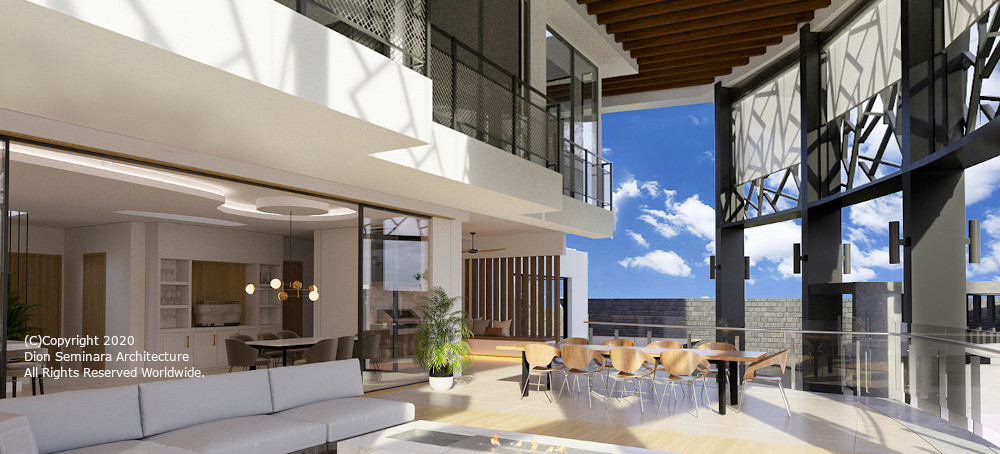



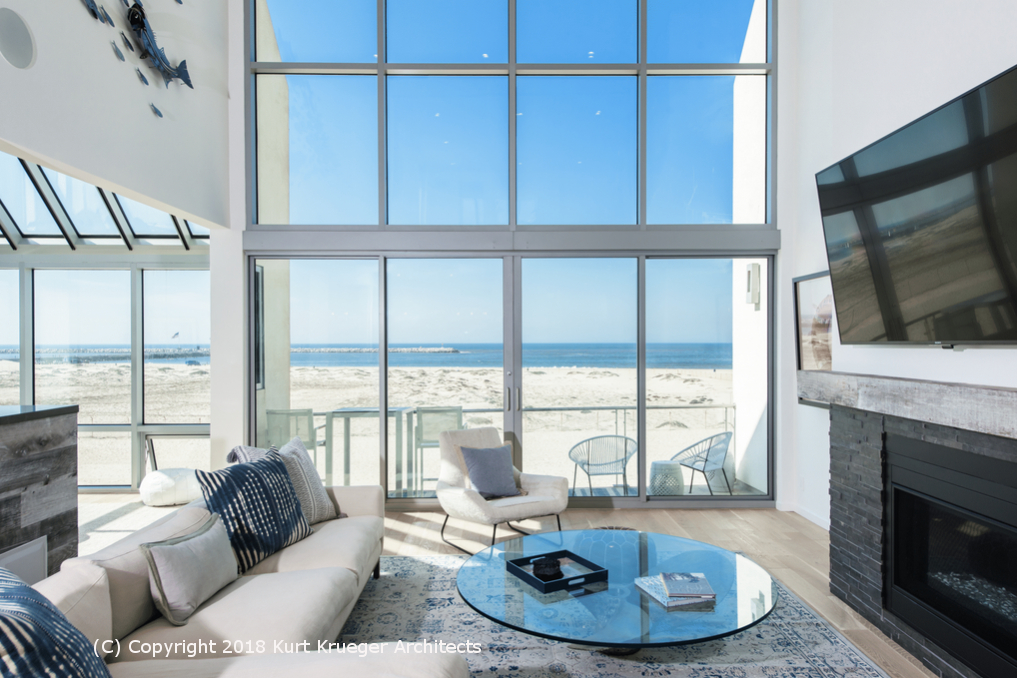



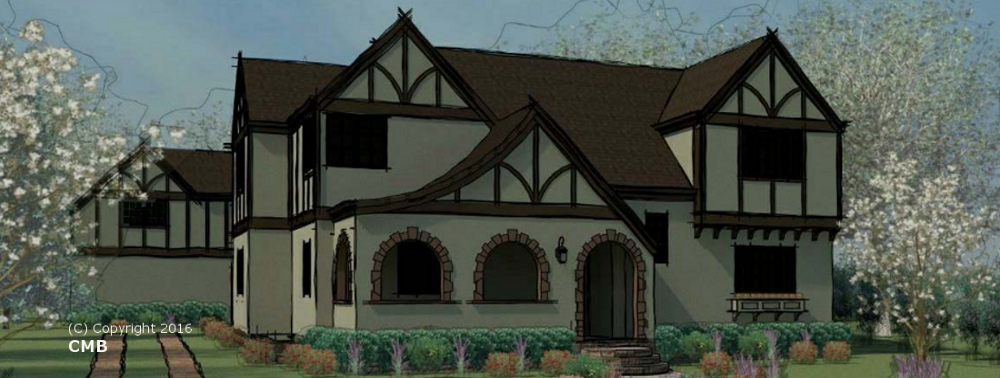


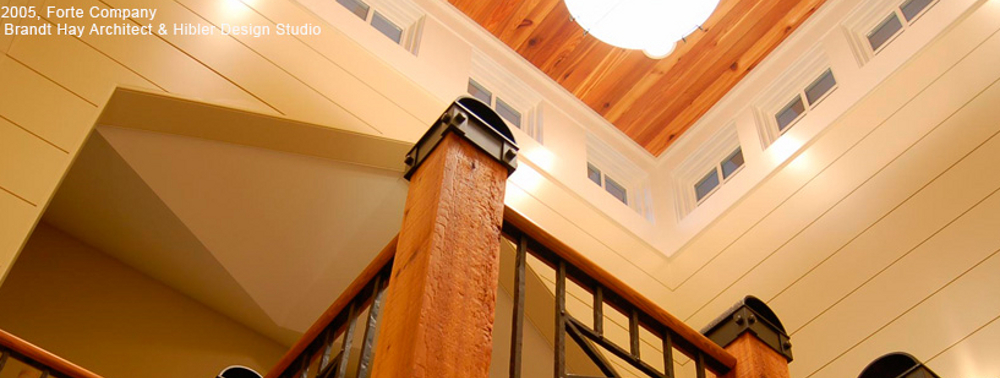








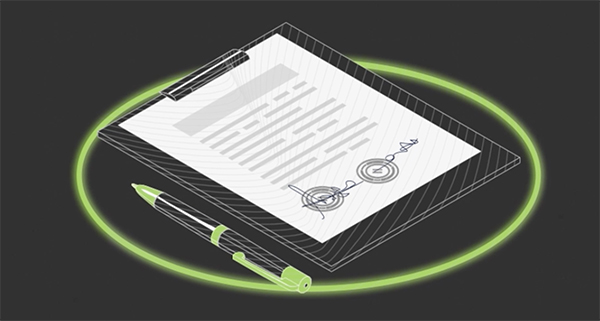
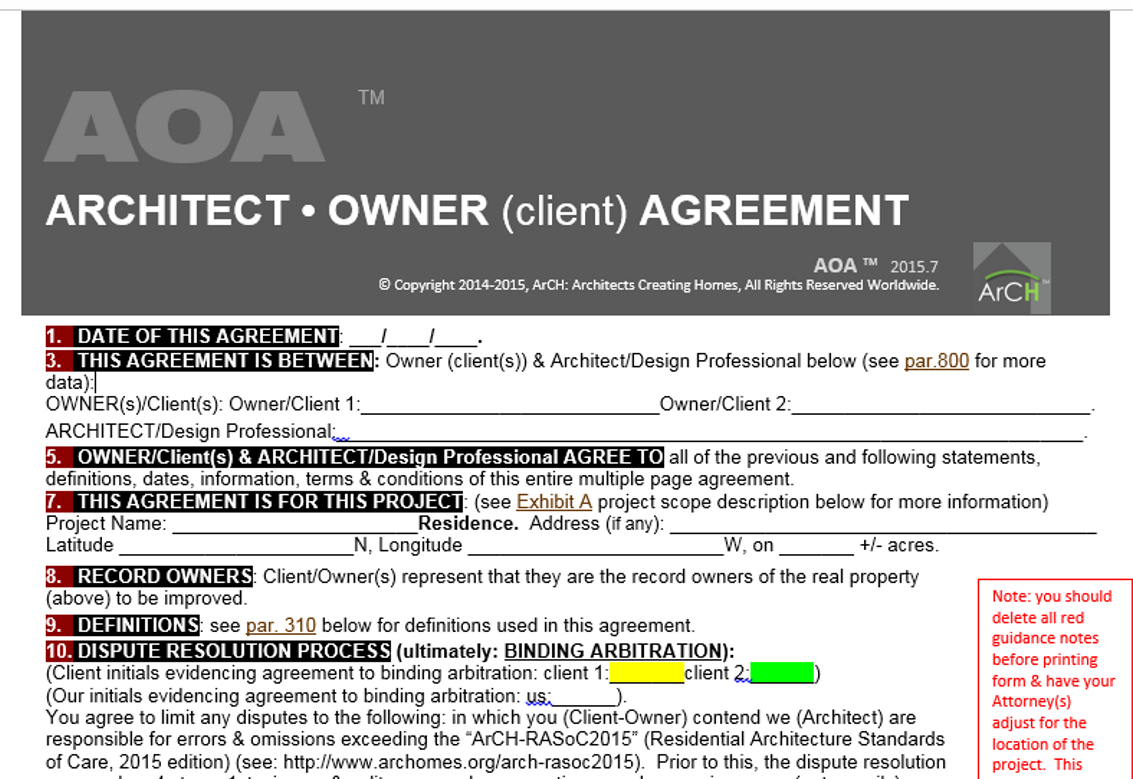
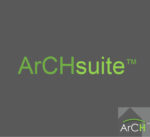


rand –
My firm has been using versions of this ArCH form for years. It has saved us countless times. It also helps to educate your clients about what an Architect does and does not do and who is responsible for what. I can’t imagine running our business without it. This form helps you get off on the right foot with your project and maintain a straightforward and understandable project process that your client can follow to align expectations of both parties. If you’re an ArCH member, you can own this for under a hundred bucks; it is worth ten times that and more. If you’re a licensed Architect who practices residential architecture, you absolutely, positively need this form of agreement. It is also compact. Once you’re done editing, it ought to be about 8 face pages which = 4 duplexed pages. When’s the last time you had a form of agreement that compact, but this complete? In agreements, size matters, with less being more in the eyes of clients. I couldn’t recommend the ArCH-AOA-2015 more.
Craig Isaac –
Recently started using this form and could have saved me thousands in Attorney’s fees had I used this a few years ago!
studio4c (verified owner) –
This form has been a great addition to the contract I had been using for the past 15 years. It is loaded with great information, easy to modify and has made me fully aware of the areas where my previous contract was lacking. ArCH-AOA-2015 truly has the residential architect in mind. Thanks!
rand soellner –
Just updated (9-3-2019) adding a provision to not allow a client to interfere with the coordination between the Architect and Structural Engineer. Note: this was done due to an ArCHmember reporting that their client did in fact interfere between the normal coordination between the Architect and the Structural Engineer on a project of theirs. ArCH is responsive to the needs of Licensed Architects who use ArCHforms.